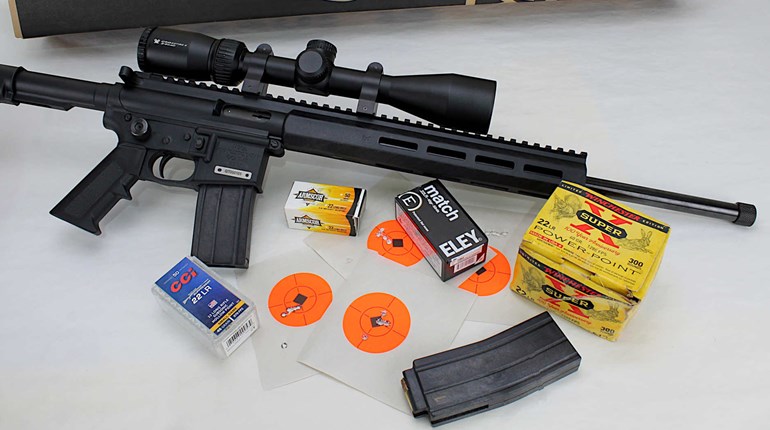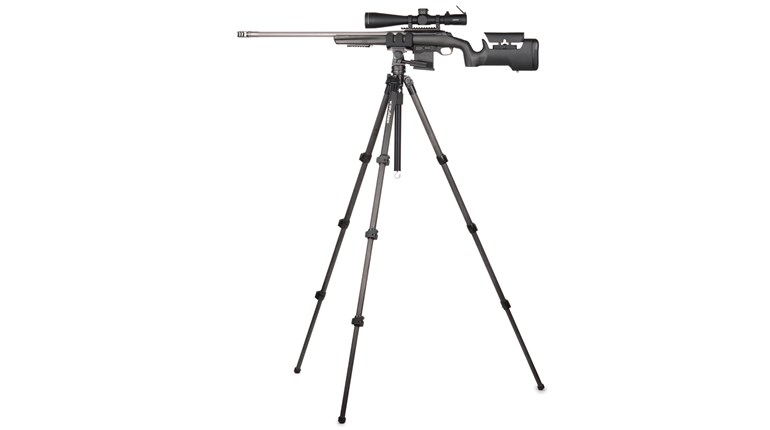
The concept of what constitutes a “packable” rifle has changed significantly for me over the past 35 years. As a 15-year-old camper, I was content to carry a disassembled Savage Arms Model 24 over/under in my external-frame rucksack. During the pre-Sept. 11 portion of my Army life, missions sometimes required me to get a full-caliber rifle into a clandestine environment undetected. I often opted to simply separate the halves of either a 5.56 NATO or 7.62 NATO AR, stowing them in bags or containers that were not as discreet as I would have liked. Smaller, special-purpose guns were available, but they usually left much to be desired when the shooting progressed to a two-way affair.
A few years back I shifted my personal focus to no-frills, lightweight and reliable carbines for use as “truck guns.” Most recently, I visited some options for maintaining caliber flexibility in rifles via switch-barrel systems in our May 2018 issue. While removable barrels reduce long gun sizes for ease of storage and transport, other shortening methods exist for those times when rapid employment still ranks above minimal package size on your list of important attributes of a rifle.
Many modern long guns can either be had from the factory or retrofitted with a folding stock, a collapsible stock or a combination of the two. Neither of these compact attributes are new concepts. The Second World War saw extensive use of each on submachine guns, while folders were employed on M1A1 Carbines and small numbers of bolt-action rifles modified for use by paratroopers and clandestine forces.
The latter half of the 20th century saw the proliferation of AK-series firearms with both side- and under-folding stocks. These readily available, compact rifles are still viable options for work in tight confines. At the same time that Mikhail Kalashnikov’s baby was spreading through the communist world, some of our NATO allies adopted bullpup configurations to reduce the overall length of their own battle rifles. Steyr’s AUG (Austria), the French FAMAS and Enfield’s SA-80 (UK) all make use of this chamber-behind-trigger design to preserve longer barrel lengths in compact packages. IWI’s supremely popular Tavor family of firearms and Kel-Tec’s RFB and RDB rifles give modern updates to the bullpup concept, providing today’s shooters with several good options for big performance in small packages.
Our own military has been slower to find solutions for shortening our fighting rifles. Armalite’s unique offering, the long-out-of-production AR-18 (and its civilian counterpart, the AR-180) offered a side-folding stock option that was neither adopted into service here nor widely successful on the commercial market.
Our M16 family of firearms has traditionally been limited to partially collapsible stocks, due to receiver extensions (buffer tubes) that protrude several inches behind receivers. Military and law enforcement communities have worked around this limitation for decades by using barrel lengths of 10 to 14.5 inches. After the Global War on Terror kicked into full stride, I carried just about any 7.62 NATO semi-automatic that I could get my hands on, provided it had a folding or fully collapsible stock. Few battle-ready options existed at the time, so I had to rely on guns that were modified in-house.
Unfortunately, civilian users of direct-impingement ARs have to choose between the NFA-registered Short Barrel Rifle (SBR) route and a fully collapsed AR stock that is not all that compact on a legal (non-NFA) 16-inch-barreled carbine. One major exception to this problem is the option of using a “Modern Sporting Pistol” such as those made on AR or SIG Sauer MCX-type receivers. I am a big fan of AR pistols, but this is the Rifles column, so I must stay in my lane here.
Thankfully, today’s aftermarket offers adapters from companies like Law Tactical and Dead Foot Arms (DFA) that allow any firearm normally using an AR-type buffer tube to have a side-folding stock (or brace). Law Tactical’s Gen III M adapter is a left-side only folder designed for transport and storage, but not for semi-auto firing while folded. I have used these folders for many years and find them to be an excellent accessory. DFA’s design is available in both left- and right-side options that incorporate its own unique buffer and bolt-carrier groups that allow it to be fired while folded. Retailing around $250 and $450 respectively, neither option is cheap—particularly if you need to maintain semi-auto function with your stock folded.
Several manufacturers also offer “PDW” (Personal Defense Weapon) kits to retrofit direct-impingement ARs with shorter, proprietary buffer and bolt-carrier groups. This setup allows wire or rail-type stocks to collapse farther forward than do the traditional collapsible stocks. PDW kits add both cost and weight, but they give us another way to shorten semi-auto rifles for ease of storage and carry. Of course, many modern semi-autos like the SIG MCX, FN America SCAR, CZ-USA 805 Bren, Beretta ARX, Kel-Tec’s SU series, Bushmaster ACR and the Galil ACE come straight from the factory with folding stocks that do not impede semi-auto firing. So, untethering from the AR platform presents you with a wide number of options from which to choose. Bolt-action rifles are in the game, too. Custom shops and a growing list of manufacturers offer folding or removable-stock systems for their turnbolts. Nemesis Arms has a neat takedown system in its Lightweight Modular Rifle that makes storage and transport easier than ever for a hard-hitting, precision rifle.
Moving over to the survival rifle side of things brings out a few simpler options for packable rifles. If you can find one, the combination .22 LR and .410-bore M6 Scout from Springfield Armory (unfortunately out of production) folds in half to make a great emergency tool. Chiappa Firearms offers a modern take on this design. Its .22 LR Badger and .22 LR over .410-bore or 20 GA Double Badgers fold in half just like the M6 Scout. The wire-stocked, single-barrel Badger is about as minimalist as you can get in a quick-to-deploy rifle these days. The AR-7 semi-auto, .22 LR takedown rifle has been around for decades in various forms. It is currently made by Henry Repeating Arms as the US Survival AR-7. Ruger offers its wildly popular 10/22 semi-automatic rimfire rifle as a Takedown configuration that packs quite small, especially with something like the Magpul Backpacker stock installed.
Many other centerfire and rimfire options are available if you go deeper into the takedown rifle category. Whether you plan to do some backwoods hiking, want an emergency long gun in the vehicle or simply like big performance in small packages, you need not look far for options today. Options abound, and more are certainly headed to shelves.





































